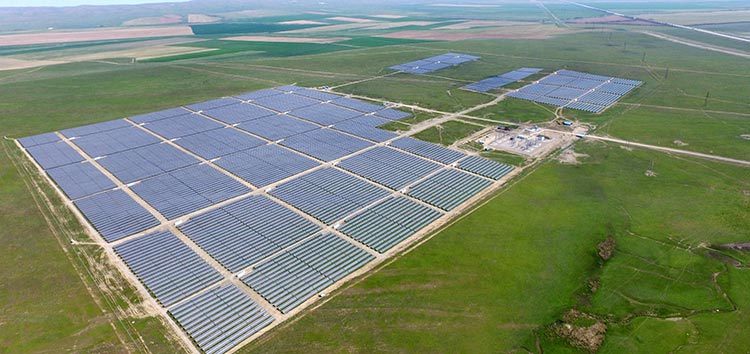Rapid economic growth in Kazakhstan has brought a sharp upswing in electricity demand and usage. Per-capita gross domestic product (GDP) increased from below US $ 6,000 in the mid-1990s to over US$ 27,000 in 2019 and the country looked on course to meet its mounting resource demands by harnessing the coal resources in the North East.
In recent years, however, Kazakhstan has moved rapidly to achieve the goals for renewable energy development set out in the National Concept for Transition to a Green Economy (GET).
A long-term engagement strategy, backed by targeted concessional financing from the EBRD and the Climate Investment Funds (CIF), has been instrumental in jumpstarting Kazakhstan’s renewables market.
Cooperation between the Government of Kazakhstan and the EBRD began in 2008 with the signing of a Sustainable Energy Action Plan (SEAP). Its main objective was to drive sustainable growth and economic diversification and to address regional imbalances within the country.
Since 2010, grant funds from the CIF’s Clean Technology Fund (CTF) have helped strengthen the country’s enabling environment and facilitated the growth in capacity and investments in the renewables sector. This was done through support for developing a robust legislative and regulatory framework, such as designing of feed-in-tariffs (FITs), establishing clear laws for investors, developing frameworks for technical, environmental and legal due diligence of projects.
Such technical assistance was complemented by project preparation funds to support first-of-its-kind projects and help private sector developers overcome the initial barriers to market entry.
Robust regulation is supporting renewable capacity growth in Kazakhstan
From 2014, US$ 433 million in EBRD investment and CTF concessional financing for 12 solar PV projects have significantly expanded private sector participation in the sector, providing over 572 megawatts (MW) of renewable generation capacity once completed. Of this, 484 MW had already been commissioned by the end of 2019, making up around 89 percent of the country’s total installed solar capacity at that time.
The EBRD-CIF partnership has enabled the sector to attract billions of dollars in clean energy investment to the country since 2013, reaching US $ 0.8 billion in 2019 alone. Investors have included other multilateral development banks (MDBs) and funds, in addition to a number of international private companies from Bulgaria, China, France, Germany, United Arab Emirates (UAE), and the United Kingdom (UK).
Renewables now provide a small but rapidly growing share of Kazakhstan’s electricity generation. Total installed capacity across the country grew to 542 MW for solar PV and 284 MW for onshore wind by the end of 2019.
The new market-based auction regime has further attracted private sector developer events as their competitive bidding for renewable projects has resulted in substantially lower prices. Compared to FiT levels, weighted average prices per kilowatt-hour (kWh) dropped by 41 percent for solar, 12 percent for wind, and 12 percent for small-scale hydropower in the 2018 and 2019 auctions.
In recent years, partners like the Green Climate Fund (GCF) have provided support to improve the auction scheme, by offering technical assistance to the authorities in preparing and implementing the first site-specific wind auction, as well as in developing a carbon market to set a price on carbon.
Renewables will become the core of the country’s power system in coming decades
Building on the success of the US $ 47 million CTF financing framework, EBRD Kazakhstan CTF Renewables Programme, the GCF is now scaling-up the approach by providing US$ 110 million in finance and grants to support the country’s ambition to do more to enhance green, clean initiatives.
In 2013, Kazakhstan, a signatory to the Paris Agreement, set national targets to bring the share of variable renewables in electricity generation to three percent by 2020, six percent in 2025, and ten percent by 2030 and, while reducing the energy intensity of its economy by 25 percent on 2008 levels by 2020, 30 percent by 2030, and 50 percent by 2050.
These targets form part of the country’s nationally determined contributions (NDCs), which aim to reduce greenhouse gas (GHG) emissions by 15 percent below 1990 levels by 2030.
By the end of 2019, the country was broadly on course to meet its 2020 targets. Solar PV, onshore wind and small hydropower were producing around 2.3 percent of the country’s electricity and large hydropower, a further nine percent.
However, ageing coal-fired plants generated almost 70 percent of electricity, with natural gas making up the rest. As a consequence, energy – power and heat generation in particular – currently accounts for 80 percent of Kazakhstan’s carbon emissions. Keeping on a path to become a green power economy could take decades.
With wind and solar potential of around 350 GW and 3760 GW respectively, there is scope for Kazakhstan to go further faster. CTF funds under the Accelerating Innovation in Renewable Energy (AIRE) program provide the opportunity to finance wind farms across the country. This is something the EBRD is actively exploring.
Continued renewables growth requires greater grid investment
Attracting further investment in renewables in Kazakhstan and achieving targets will require addressing one of the major barriers to further growth: its power grid. Much of the current grid is old and loses around 13 percent of the annual power generated.
Investment is already flowing into the sector. For instance, the EBRD and its partners, have provided around US $ 30 million in finance through its Kazakhstan Renewables Framework to the Mangistau Regional Distribution Company (MREK). This will enable MREK, a major power utility and grid operator in Western Kazakhstan, to invest in modernisation of the existing substations and distribution, new power lines, and the installation of data and automatic control systems.
Grid infrastructure and capacity need to be a major focus in coming years because so much investment in renewables and green end-user technologies such as electric vehicles depends on it. The EBRD and CIF’s long-term engagement continues with the recently approved Technical Assistance Facility (CIF-TAF) funding programme that will work with the Kazakhstan Electricity Grid Operating Company (KEGOC) on integrating renewables through enhanced tools, procedures and modernization of grid infrastructure.
Strong economic arguments for moving away from domestic consumption of fossil fuels
Kazakhstan is a major energy exporter. In 2018, it was the world’s 9th-largest exporter of coal, 9th of crude oil and 12th of natural gas.
Meeting more of its domestic energy demand through plentiful and affordable renewable power rather than heavily subsidised fossil fuels can deliver a range of environmental, health and economic benefits and free up more fuel for export.
For instance, Kazakhstan could see its fiscal revenues drop by around 40% versus business-as-usual should its oil exports be hit by countries adopting greener energy practices in line with the Paris Agreement, according to the EBRD’s own research. This could lead to unsustainable levels of debt and potentially deplete the country’s national savings from oil within a decade.
In this sense, recent volatility in the oil markets as a result of the coronavirus pandemic is a preview of what is to come and may encourage the Government of Kazakhstan to accelerate the transition to renewables and energy efficiency programmes that are already underway.
Certainly, the economic damage wrought by the pandemic presents an opportunity to build back better by ensuring the recovery is green. Kazakhstan’s international partners must provide the financing and support to ensure the momentum built up over the last decade is not lost.





